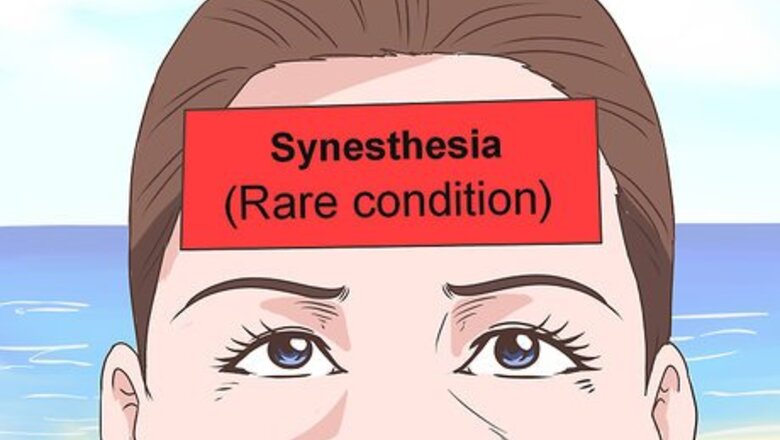
views
X
Research source
For example, someone with synesthesia may be able to hear colors, feel sounds, or taste shapes. At times this feeling is only subjective. Most people with synesthesia are born with the condition, so they don't know anything different. However, once they tell people how they experience the world, they might be told they're hallucinating or going crazy. Being diagnosed with synesthesia is often a relief in these situations. Be aware that there is no medical consensus on whether or not this condition exists, and some doctors may not recognize synesthesia as a legitimate condition.
Recognizing the Signs of Synesthesia
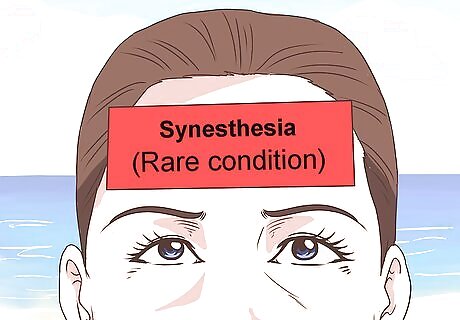
Realize that synesthesia is relatively rare but likely under-diagnosed. Synesthesia is considered a rare neurological condition that affects the senses, but it's likely that many people who have it are either undiagnosed or assume that others perceive the world just like them. It is unknown how many people have synesthesia.
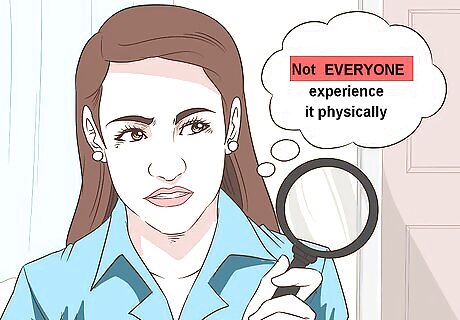
Know that not everyone with synesthesia experiences it physically. If you actually see colors in the air, smell, hear or feel things, you have projective synesthesia. This form of synesthesia is rarer than associative synesthesia and is what people first think of as synesthesia. Some people with synesthesia (called synesthetes) hear, smell, taste or feel pain in color. Others can taste shapes or perceive written letters and words in different colors. For example, they may see an "F" in red and a "P" in yellow when they read. Some synesthetes see abstract concepts, such as abstract shapes, units of time or mathematical equations floating in space outside their bodies — this is termed "conceptual synesthesia."
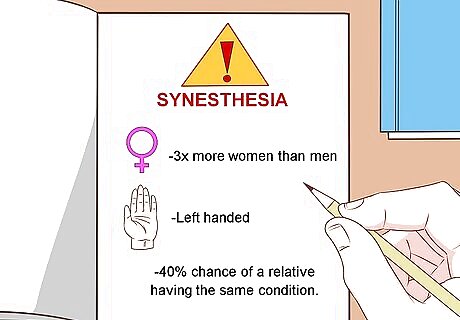
Identify your risk factors for synesthesia. According to research done in the U.S., there are some factors strongly associated with synesthesia. For example, about 3x more women than men have synesthesia in the U.S. People who have synesthesia are also much more likely to be left-handed and have a 40% chance of a relative having the same condition.
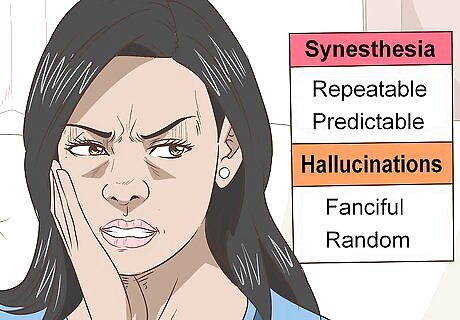
Don't confuse synesthesia with hallucinations. Often when people talk of their synesthesia, others assume they are hallucinating or on drugs. What distinguishes true synesthesia experiences from hallucinations is that they are repeatable and predictable, not fanciful and random. For example, if you taste strawberries when you hear a certain song, then one must always trigger the other sensation in a predictable fashion to be considered a synesthete. It doesn't always have to be two-way, though. Synesthetes often note being teased and ridiculed (usually starting in childhood) for describing sensory experiences that others can't experience.
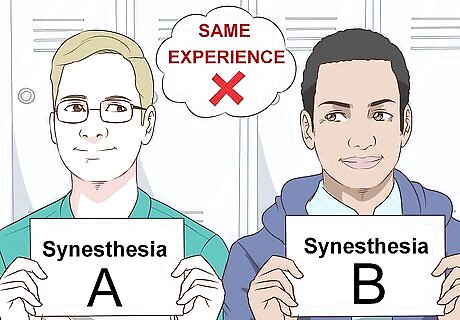
Be aware that no two people with synesthesia have the same experience. Synesthesia is a sort of cross-wiring of the nerves and brain synapses related to the five senses. And no two synesthetes have the exact same wiring scheme. For example, the most common form of synesthesia is grapheme-color, when numbers and letters each have their own color. The colors assigned to each letter are different for everyone, but many people have red A's. Another common form is chromesthesia, or colored hearing — sounds, music or voices that are heard and also trigger the eyes to see colors. However, someone may see the color red whenever they hear the word "dog", whereas another might see the color orange. Synesthetic perceptions are specific to each person. I have questioned my own sanity. "I can see lines with sounds, and feel and see colors from the pitch in people's voices. I didn't know anyone else that was experiencing this and thought I was hallucinating. I have spoken to people about this a few times throughout my life, but it never really went anywhere and I kept trying to ignore it, especially at work. I feel relieved to know that there are so many times of synesthesia, and I have two of them!" - Tom S. I thought I was weird. "Whenever I feel any emotion, I always see a color. I love painting, and I am also being evaluated for tetrachromacy. This article really helped me to see that there are so many others like me!" - Laura O. Have a story our readers should hear? Share it with 1 billion+ annual wikiHow users. Tell us your story here.
Getting a Professional Diagnosis
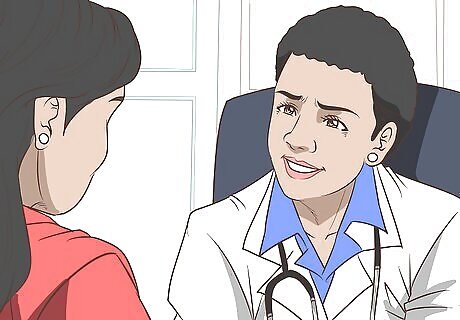
See your primary care doctor. Because the sensations of synesthesia can mimic certain medical conditions and head injuries, it's a good idea to see your doctor to rule out anything serious. They will check the functioning of your brain, reflexes, and senses to see if you have any physical problems or deficits. If they believe that it is something serious, they might refer you to a neurologist. Keep in mind that people with synesthesia typically pass all standard neurological exams and are considered normal in that way. If you have a neurological deficit that's causing visual sensations, then you're very unlikely to also have synesthesia. Head trauma, post-concussion syndrome, brain tumors, brain infections, migraine headaches, seizures with auras, epilepsy, cerebral stroke, toxic reactions, LSD "flashbacks" and experimentation with hallucinogens (peyote, mushrooms) can all produce sensory phenomena similar to synesthesia. Synesthesia is usually present from birth, so developing it as an adult is extremely rare. If it comes on suddenly in adulthood, see your doctor immediately for an assessment because it could be related to a problem with your brain / nervous system.
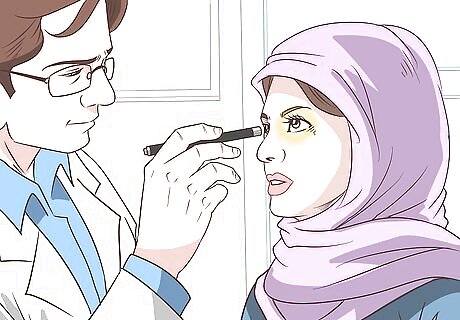
See an eye doctor. Some visual sensations of synesthesia can also mimic certain eye diseases and conditions, so it's a good idea to see an optometrist or an ophthalmologist to get your eyes examined. Eye trauma, glaucoma (pressure in the eye), cataracts, retinal or vitreous detachment, corneal edema, macular degeneration, and optic nerve dysfunction are all eye conditions that can produce visual phenomena and color distortion. The vast majority of people with synesthesia do not suffer from any physical ailments of their eyes. An ophthalmologist (eye disease specialists) is likely a better choice than an optometrist, who mainly focuses on determining the acuity of your eyesight and prescribing glasses/contacts.
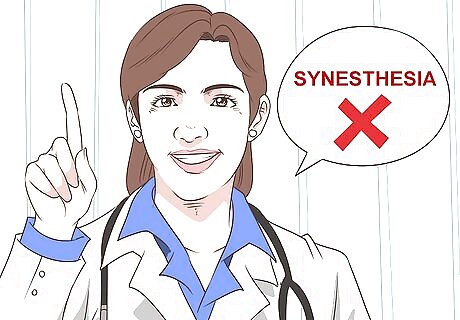
Understand that some doctors do not believe in synesthesia. You may encounter some doctors who do not believe that the condition exists. Furthermore, some insurance companies may not cover treatment. You should still visit a doctor to rule out any underlying conditions that might be causing your symptoms, but be aware that your doctor might diagnose it as something else entirely. You may want to get a second opinion if you believe that your concerns are not being taken seriously by the doctor. If your doctor says you do not have synesthesia but have a different condition entirely, trust their advice, and follow their instructions for treatment.



















Comments
0 comment